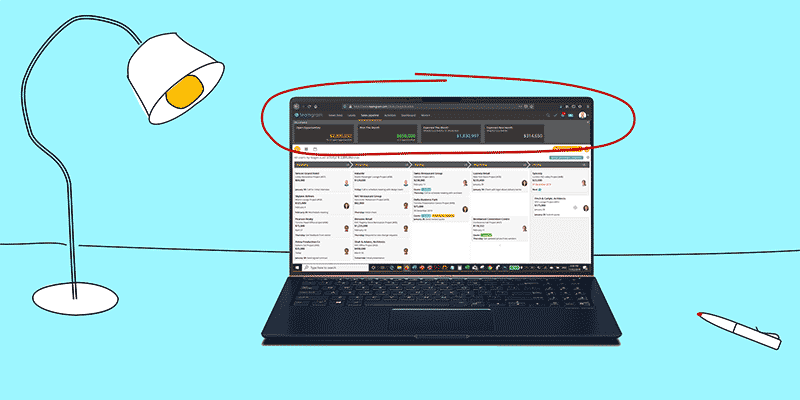Before We Begin:
Consistent sales growth requires two separate processes working together:
- Lead Generation and Qualification: You can’t rely solely on existing customers to grow sales. You also need a constant inflow of new leads (potential buyers) and a method to identify the ones presenting real opportunities. For more information on how to generate and qualify leads, check out this article.
- The Sales Pipeline: Once you identify an opportunity, you will start another process known as the sales pipeline. The sales pipeline is a repeatable, manageable process designed to get your potential customers to buy from you. The article below covers the essentials of building and running this process.
Each sale your team is trying to close is an opportunity. Everything that happens between the creation and closing of an opportunity is part of the sales process.
Companies design their own sales processes. Factors like past experiences of the sales team, expectations of potential buyers, technical capabilities, and competition will influence the sales process a particular company will use.
Why Do You Need to Build a Sales Process?
Processes make a business more scalable. If you have a repeatable sales process, you can grow your team as needed, without having to micro-manage every step along the way. That sets the stage for rapid sales growth.
Processes also run more efficiently than ad hoc actions. The results are predictable. They are easy to manage. New team members can adapt faster and become productive earlier if you have a well-designed sales process.
Designing a scalable sales process is one of the best investments you can make for the future of your business. Consistently high sales growth is rarely achievable without one.
Determining The Stages in Your Sales Process
A process consists of a series of stages. No matter how obvious they seem, explicitly defining them is essential.
Here are the stages of a typical B2B sales process:
Introduction > Needs Analysis > Quoting > Negotiation > Contract
These stages will differ from one business to the other, even within the same industry. Some companies also have multiple sales processes for different customer segments or products.
Every opportunity will pass through these stages in the same order. Some may move faster, and sometimes they may even have to go back to a previous stage, but they must always move through the same order of stages.
In the example above, sending a quote before conducting a needs analysis, or negotiating terms only after signing a contract would be unacceptable.
TeamGram’s sales pipeline page visualizes your sales process with different columns for each stage. Administrators can customize this view for their users: They can add, delete, rename, or change the order of columns. Some TeamGram subscription plans also support multiple sales pipelines with different stages.
Adding Opportunities to The Sales Pipeline
Once you have set up your sales pipeline with the right columns, you can start adding opportunities to it.
Every sales opportunity your team is working on must appear somewhere in the pipeline.
Defining a sales opportunity requires entering some information: customer name, estimated closing date, expected value, probability, etc. The more information you enter, the better you can manage the process and forecast future sales.
Use the new opportunity button at the upper right corner of the sales pipeline page to add opportunities to TeamGram. Alternatively, locate the customer’s CRM record and use the new opportunity button there.
As your sales opportunity moves through the process, you can easily update it by dragging and dropping from one stage to another.
You can organize and filter your sales pipeline view in different ways. To do this, click on the filter symbol in the upper left corner.
Sales Forecasts
You can enter an estimated sales value, expected closing date, and the success probability for each opportunity. TeamGram uses this information to make sales forecasts.
To calculate probable sales in the future, TeamGram multiplies the sales values and probabilities of each opportunity to calculate weighted amounts for the specified closing dates.
Some of this information may be difficult to estimate, especially in the early stages of an opportunity. Nevertheless, enter your best estimates here. You can always come back and update them later. After every update, TeamGram’s forecast calculations will change automatically.
Who Owns a Sales Opportunity?
Selling requires teamwork, but it’s also very individualistic and competitive. Every opportunity must have an owner who is ultimately responsible for winning it.
The owner needs to be someone in close contact with the customer and the best person to make critical decisions that will ultimately determine the fate of the opportunity.
You must set the owner of an opportunity when you create it. Only owners and their managers are authorized to make critical updates on opportunities.
Avoid assigning a person as the owner of opportunities they don’t directly manage. Doing so makes your sales process less scalable and tracking the individual performance of sales team members more difficult. Whoever is directly responsible for an opportunity must be its owner.
TeamGram’s sales pipeline view can display opportunities owned by different team members on the same page. You can apply filters to view the opportunities owned by a single user, everyone in a department, or the entire company in the same pipeline view.
Identifying Next Steps
The sales pipeline view in TeamGram clearly displays the stage of each opportunity. This information helps salespeople to focus on the relevant issues quickly. For example, knowing that an opportunity is in the negotiation stage narrows down the issues that need attention. It also makes it easy to plan for what’s coming next. However, this is not enough.
Any task you need to complete to move an opportunity forward in the sales process is called an activity. Examples of sales activities include meeting with customers, sending quotes, and making follow up calls. Numerous activities may be necessary to move an opportunity from one stage to the next.
Unlike stages, the exact sequence of individual activities that will be needed to push an opportunity forward can’t always be pre-determined. For example, each sales opportunity may need to go through a need analysis stage. But what kind of activities will be required to pass that stage may vary from one opportunity to the next. Sometimes this can be done with a single meeting. At other times multiple meetings and a thorough examination of technical specifications may be necessary.
Usually, the owner of a sales opportunity decides on what to do next, based on the situation. It is more realistic to plan activities step-by-step, as things move forward.
TeamGram shows the next step of each sales opportunity in the sales pipeline view. You can define more than one activity for each sales opportunity, but only the first upcoming one will be visible in the sales pipeline. When you complete it, the next one replaces it. You can click on a sales opportunity to view all activities planned for it and schedule new ones.
Good salespeople always plan the next steps for the opportunities they own. Make sure every opportunity in your sales pipeline has a next step. In a dynamic sales environment, everything may not go as expected. You may have to change the next steps without you have a chance to complete them. That’s normal. Not having a next step is not.
Creating Product Tables
You can add a product table to every sales opportunity. The product table shows the products you want to sell, the quantities and unit prices, as well as the discounts you intend to apply. Using a product table makes your job easier:
- You can easily calculate the estimated value of the opportunity.
- Discount and currency conversion calculations are simplified.
- You can easily update the opportunity value when products, quantities, prices, and discounts change.
Moreover, you can automatically create a quote document with the information in the product table, and email it to your customer (only available in some subscription plans).
If you have already defined the unit prices of your products and services in the products section of TeamGram, the product table will automatically pull up that information and calculate the totals for you without requiring you to re-enter unit prices for each line item.
Keep Your Eyes On The Sales Dashboard
The sales dashboard section at the top of the pipeline page displays essential metrics calculated with live data from your opportunities.
Keep an eye on them to gain insights into your team’s performance and forecast future sales.

